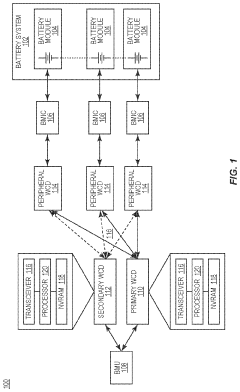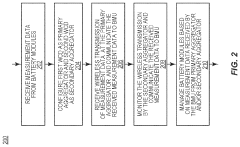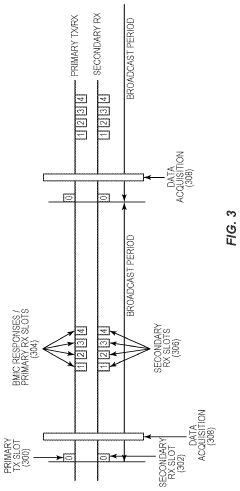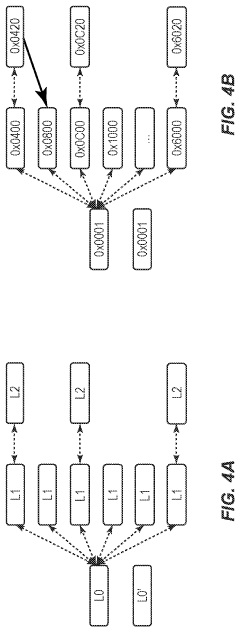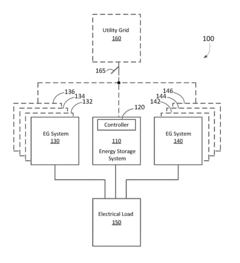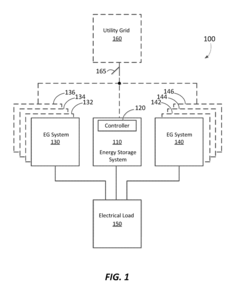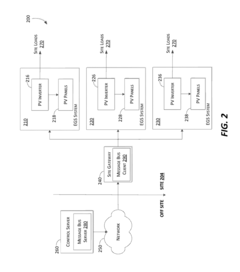Battery Management Systems’ Role in Ensuring Power Quality in Microgrids
AUG 8, 20259 MIN READ
Generate Your Research Report Instantly with AI Agent
Patsnap Eureka helps you evaluate technical feasibility & market potential.
BMS in Microgrids: Background and Objectives
Battery Management Systems (BMS) have emerged as a critical component in the evolution of microgrids, playing a pivotal role in ensuring power quality and stability. The development of BMS technology can be traced back to the early 2000s, coinciding with the rise of renewable energy sources and the increasing complexity of power distribution systems. As microgrids gained prominence as a solution for localized energy management, the need for sophisticated battery management became apparent.
The primary objective of integrating BMS into microgrids is to optimize the performance, reliability, and longevity of energy storage systems. This integration addresses several key challenges in microgrid operations, including power fluctuations from intermittent renewable sources, load balancing, and overall system efficiency. BMS technology has evolved from simple voltage and current monitoring to advanced predictive analytics and real-time optimization algorithms.
In the context of microgrids, BMS serves multiple functions beyond traditional battery protection. It acts as a crucial interface between energy storage units and the broader microgrid control system, facilitating seamless energy flow and maintaining power quality. The technology aims to enhance grid resilience, improve energy utilization, and enable more effective integration of diverse energy sources within the microgrid ecosystem.
Recent technological advancements have expanded the capabilities of BMS in microgrids. Machine learning algorithms are now being incorporated to predict energy demand patterns and optimize charging/discharging cycles. Additionally, the integration of Internet of Things (IoT) technologies has enabled more granular monitoring and control of individual battery cells, further improving overall system performance.
The evolution of BMS in microgrids is closely tied to advancements in battery technology, particularly the widespread adoption of lithium-ion batteries. As energy storage systems become more sophisticated, BMS must adapt to manage increasingly complex battery chemistries and configurations. This ongoing development is driven by the need for higher energy densities, faster charging capabilities, and longer battery lifespans.
Looking forward, the trajectory of BMS in microgrids is expected to focus on enhancing interoperability with diverse energy sources and grid configurations. There is a growing emphasis on developing standardized protocols for BMS communication within microgrids, facilitating easier integration and scalability. Furthermore, as microgrids play an increasingly important role in grid modernization efforts, BMS technology is poised to become a cornerstone in ensuring reliable, efficient, and sustainable power distribution.
The primary objective of integrating BMS into microgrids is to optimize the performance, reliability, and longevity of energy storage systems. This integration addresses several key challenges in microgrid operations, including power fluctuations from intermittent renewable sources, load balancing, and overall system efficiency. BMS technology has evolved from simple voltage and current monitoring to advanced predictive analytics and real-time optimization algorithms.
In the context of microgrids, BMS serves multiple functions beyond traditional battery protection. It acts as a crucial interface between energy storage units and the broader microgrid control system, facilitating seamless energy flow and maintaining power quality. The technology aims to enhance grid resilience, improve energy utilization, and enable more effective integration of diverse energy sources within the microgrid ecosystem.
Recent technological advancements have expanded the capabilities of BMS in microgrids. Machine learning algorithms are now being incorporated to predict energy demand patterns and optimize charging/discharging cycles. Additionally, the integration of Internet of Things (IoT) technologies has enabled more granular monitoring and control of individual battery cells, further improving overall system performance.
The evolution of BMS in microgrids is closely tied to advancements in battery technology, particularly the widespread adoption of lithium-ion batteries. As energy storage systems become more sophisticated, BMS must adapt to manage increasingly complex battery chemistries and configurations. This ongoing development is driven by the need for higher energy densities, faster charging capabilities, and longer battery lifespans.
Looking forward, the trajectory of BMS in microgrids is expected to focus on enhancing interoperability with diverse energy sources and grid configurations. There is a growing emphasis on developing standardized protocols for BMS communication within microgrids, facilitating easier integration and scalability. Furthermore, as microgrids play an increasingly important role in grid modernization efforts, BMS technology is poised to become a cornerstone in ensuring reliable, efficient, and sustainable power distribution.
Market Analysis for BMS in Microgrid Applications
The market for Battery Management Systems (BMS) in microgrid applications is experiencing significant growth, driven by the increasing adoption of renewable energy sources and the need for reliable power distribution in both developed and developing regions. As microgrids become more prevalent in various sectors, including commercial, industrial, and residential, the demand for sophisticated BMS solutions is escalating.
The global microgrid market is projected to expand rapidly, with a compound annual growth rate (CAGR) exceeding 10% over the next five years. This growth is primarily fueled by the rising need for energy security, grid resilience, and the integration of distributed energy resources. Within this expanding market, BMS plays a crucial role in ensuring power quality and optimal energy management.
Key market drivers for BMS in microgrid applications include the increasing deployment of energy storage systems, particularly lithium-ion batteries, which require advanced management for safety and efficiency. The push for grid modernization and smart city initiatives in many countries is also contributing to market growth, as these projects often incorporate microgrids with integrated BMS.
The industrial sector represents a significant portion of the BMS market for microgrids, as manufacturing facilities and data centers seek to enhance their energy reliability and reduce operational costs. Commercial buildings and campuses are also adopting microgrid solutions with BMS to achieve energy independence and sustainability goals.
Geographically, North America and Europe are leading the market due to their advanced infrastructure and supportive regulatory environments. However, the Asia-Pacific region is expected to witness the fastest growth, driven by rapid industrialization, urbanization, and government initiatives to improve power quality and reliability.
Challenges in the market include the high initial investment costs associated with implementing comprehensive BMS solutions in microgrids and the complexity of integrating diverse energy sources and storage systems. Additionally, concerns about cybersecurity in increasingly connected energy systems present both a challenge and an opportunity for BMS providers to differentiate their offerings.
The competitive landscape is characterized by a mix of established electrical equipment manufacturers, specialized BMS providers, and emerging startups. Key players are focusing on developing more intelligent and scalable BMS solutions that can adapt to the dynamic nature of microgrids and provide advanced analytics for optimized energy management.
As the market matures, there is a growing trend towards modular and standardized BMS solutions that can be easily integrated into various microgrid configurations. This approach aims to reduce implementation costs and complexity, making BMS more accessible to a broader range of microgrid applications.
The global microgrid market is projected to expand rapidly, with a compound annual growth rate (CAGR) exceeding 10% over the next five years. This growth is primarily fueled by the rising need for energy security, grid resilience, and the integration of distributed energy resources. Within this expanding market, BMS plays a crucial role in ensuring power quality and optimal energy management.
Key market drivers for BMS in microgrid applications include the increasing deployment of energy storage systems, particularly lithium-ion batteries, which require advanced management for safety and efficiency. The push for grid modernization and smart city initiatives in many countries is also contributing to market growth, as these projects often incorporate microgrids with integrated BMS.
The industrial sector represents a significant portion of the BMS market for microgrids, as manufacturing facilities and data centers seek to enhance their energy reliability and reduce operational costs. Commercial buildings and campuses are also adopting microgrid solutions with BMS to achieve energy independence and sustainability goals.
Geographically, North America and Europe are leading the market due to their advanced infrastructure and supportive regulatory environments. However, the Asia-Pacific region is expected to witness the fastest growth, driven by rapid industrialization, urbanization, and government initiatives to improve power quality and reliability.
Challenges in the market include the high initial investment costs associated with implementing comprehensive BMS solutions in microgrids and the complexity of integrating diverse energy sources and storage systems. Additionally, concerns about cybersecurity in increasingly connected energy systems present both a challenge and an opportunity for BMS providers to differentiate their offerings.
The competitive landscape is characterized by a mix of established electrical equipment manufacturers, specialized BMS providers, and emerging startups. Key players are focusing on developing more intelligent and scalable BMS solutions that can adapt to the dynamic nature of microgrids and provide advanced analytics for optimized energy management.
As the market matures, there is a growing trend towards modular and standardized BMS solutions that can be easily integrated into various microgrid configurations. This approach aims to reduce implementation costs and complexity, making BMS more accessible to a broader range of microgrid applications.
Current BMS Technologies and Challenges in Microgrids
Battery Management Systems (BMS) play a crucial role in ensuring power quality within microgrids. Current BMS technologies in microgrids focus on optimizing battery performance, extending lifespan, and maintaining safe operation. Advanced BMS solutions incorporate real-time monitoring, predictive analytics, and adaptive control algorithms to manage energy storage systems effectively.
One of the primary technologies employed in modern BMS is cell balancing. This technique ensures that all cells within a battery pack maintain similar voltage levels, preventing overcharging or undercharging of individual cells. Active and passive balancing methods are used, with active balancing gaining popularity due to its higher efficiency and ability to redistribute energy between cells.
State of charge (SOC) and state of health (SOH) estimation algorithms have seen significant improvements in recent years. Machine learning and artificial intelligence techniques are being integrated into BMS to enhance the accuracy of these estimations. These advanced algorithms consider various factors such as temperature, charge/discharge cycles, and voltage fluctuations to provide more precise predictions of battery performance and remaining useful life.
Thermal management is another critical aspect of current BMS technologies. Sophisticated cooling systems and temperature monitoring devices are employed to maintain optimal operating conditions for batteries. This is particularly important in microgrid applications where batteries may be subjected to varying environmental conditions and high-power demands.
Communication and integration capabilities have become increasingly important in BMS design for microgrids. Modern systems utilize protocols such as CAN, Modbus, or Ethernet to facilitate seamless communication with other microgrid components, including inverters, renewable energy sources, and energy management systems. This integration allows for more efficient energy distribution and improved overall system performance.
Despite these advancements, several challenges persist in the implementation of BMS in microgrids. One significant challenge is the complexity of managing diverse battery chemistries and configurations within a single microgrid. Different battery types may have varying charging profiles, thermal characteristics, and performance parameters, requiring sophisticated BMS algorithms to optimize their collective operation.
Scalability and flexibility remain ongoing challenges for BMS in microgrids. As energy storage requirements grow and evolve, BMS must be able to accommodate expanding battery capacities and changing system architectures without compromising performance or reliability. This necessitates modular designs and adaptable software solutions that can be easily upgraded or reconfigured.
Cybersecurity is an emerging concern in BMS for microgrids. As these systems become more interconnected and reliant on digital communication, they become potential targets for cyber attacks. Ensuring the security and integrity of BMS data and control systems is crucial to maintain the reliability and stability of microgrid operations.
Lastly, the cost-effectiveness of advanced BMS technologies remains a challenge, particularly for smaller microgrid installations. Balancing the need for sophisticated features with economic viability is an ongoing consideration for BMS developers and microgrid operators.
One of the primary technologies employed in modern BMS is cell balancing. This technique ensures that all cells within a battery pack maintain similar voltage levels, preventing overcharging or undercharging of individual cells. Active and passive balancing methods are used, with active balancing gaining popularity due to its higher efficiency and ability to redistribute energy between cells.
State of charge (SOC) and state of health (SOH) estimation algorithms have seen significant improvements in recent years. Machine learning and artificial intelligence techniques are being integrated into BMS to enhance the accuracy of these estimations. These advanced algorithms consider various factors such as temperature, charge/discharge cycles, and voltage fluctuations to provide more precise predictions of battery performance and remaining useful life.
Thermal management is another critical aspect of current BMS technologies. Sophisticated cooling systems and temperature monitoring devices are employed to maintain optimal operating conditions for batteries. This is particularly important in microgrid applications where batteries may be subjected to varying environmental conditions and high-power demands.
Communication and integration capabilities have become increasingly important in BMS design for microgrids. Modern systems utilize protocols such as CAN, Modbus, or Ethernet to facilitate seamless communication with other microgrid components, including inverters, renewable energy sources, and energy management systems. This integration allows for more efficient energy distribution and improved overall system performance.
Despite these advancements, several challenges persist in the implementation of BMS in microgrids. One significant challenge is the complexity of managing diverse battery chemistries and configurations within a single microgrid. Different battery types may have varying charging profiles, thermal characteristics, and performance parameters, requiring sophisticated BMS algorithms to optimize their collective operation.
Scalability and flexibility remain ongoing challenges for BMS in microgrids. As energy storage requirements grow and evolve, BMS must be able to accommodate expanding battery capacities and changing system architectures without compromising performance or reliability. This necessitates modular designs and adaptable software solutions that can be easily upgraded or reconfigured.
Cybersecurity is an emerging concern in BMS for microgrids. As these systems become more interconnected and reliant on digital communication, they become potential targets for cyber attacks. Ensuring the security and integrity of BMS data and control systems is crucial to maintain the reliability and stability of microgrid operations.
Lastly, the cost-effectiveness of advanced BMS technologies remains a challenge, particularly for smaller microgrid installations. Balancing the need for sophisticated features with economic viability is an ongoing consideration for BMS developers and microgrid operators.
Existing BMS Solutions for Microgrid Power Quality
01 Battery Management System Architecture
Battery Management Systems (BMS) are designed with specific architectures to monitor and control battery performance, ensuring optimal power quality. These systems typically include components for voltage and current monitoring, temperature sensing, and state-of-charge estimation. Advanced BMS architectures may incorporate machine learning algorithms for predictive maintenance and performance optimization.- Battery Management System Architecture: Battery Management Systems (BMS) are designed with specific architectures to monitor and control battery performance, ensuring optimal power quality. These systems typically include components for voltage and current monitoring, temperature sensing, and state-of-charge estimation. Advanced BMS architectures may incorporate machine learning algorithms for predictive maintenance and improved power quality management.
- Power Quality Improvement Techniques: Various techniques are employed in Battery Management Systems to enhance power quality. These may include active balancing, adaptive charging algorithms, and intelligent load management. Advanced filtering and power conditioning methods are also implemented to reduce harmonics and voltage fluctuations, thereby improving overall power quality and extending battery life.
- Integration with Renewable Energy Systems: Battery Management Systems are increasingly integrated with renewable energy sources to improve power quality in hybrid systems. This integration involves sophisticated control algorithms that manage power flow between batteries, renewable sources, and the grid. Such systems often incorporate forecasting models to optimize energy storage and distribution, enhancing overall system reliability and power quality.
- Smart Grid and Vehicle-to-Grid Applications: Advanced Battery Management Systems are being developed for smart grid and vehicle-to-grid (V2G) applications. These systems focus on bidirectional power flow, grid stabilization, and demand response capabilities. They incorporate communication protocols and control strategies to interact with the grid intelligently, contributing to overall power quality improvement at both local and grid levels.
- Fault Detection and Diagnostics: Modern Battery Management Systems incorporate sophisticated fault detection and diagnostic capabilities to maintain power quality. These systems use real-time monitoring and analysis to identify potential issues such as cell imbalance, capacity fade, or thermal runaway. Advanced algorithms and sensor technologies are employed to predict and prevent power quality degradation, ensuring system reliability and safety.
02 Power Quality Improvement Techniques
Various techniques are employed in BMS to improve power quality, including active balancing, voltage regulation, and harmonic reduction. These methods help maintain stable voltage levels, reduce power losses, and extend battery life. Advanced power electronics and control algorithms are utilized to minimize power fluctuations and ensure smooth energy delivery.Expand Specific Solutions03 Thermal Management in BMS
Effective thermal management is crucial for maintaining power quality in battery systems. BMS incorporate temperature monitoring and control mechanisms to prevent overheating and ensure optimal operating conditions. This may include active cooling systems, heat dissipation techniques, and thermal runaway prevention strategies.Expand Specific Solutions04 State Estimation and Monitoring
Advanced state estimation techniques are employed in BMS to accurately determine battery parameters such as state-of-charge, state-of-health, and remaining useful life. These estimations are critical for maintaining power quality and optimizing battery performance. Real-time monitoring and data analytics are used to provide accurate insights into battery conditions.Expand Specific Solutions05 Grid Integration and Energy Management
BMS play a crucial role in integrating battery systems with power grids and managing energy flow. This includes features such as bidirectional power flow control, demand response capabilities, and smart charging strategies. Advanced BMS incorporate communication protocols and energy management algorithms to optimize power quality in grid-connected applications.Expand Specific Solutions
Key Players in BMS and Microgrid Industries
The Battery Management Systems (BMS) market for microgrids is in a growth phase, driven by increasing adoption of renewable energy and energy storage solutions. The market size is expanding rapidly, with projections indicating significant growth in the coming years. Technologically, BMS for microgrids is advancing, with companies like Tesla, Samsung SDI, and Contemporary Amperex Technology leading innovation. These firms are developing more sophisticated, efficient, and reliable BMS solutions, integrating advanced features such as AI-driven predictive maintenance and cloud connectivity. However, the technology is still evolving, with ongoing research focused on improving battery life, safety, and overall system performance in microgrid applications.
Honeywell International Technologies Ltd.
Technical Solution: Honeywell's Battery Management System for microgrids focuses on reliability and efficiency in industrial and commercial applications. Their system utilizes a distributed control architecture with redundant components to ensure high availability. Honeywell's BMS incorporates advanced thermal management techniques, optimizing battery performance across a wide range of environmental conditions. The system employs proprietary algorithms for accurate SOC and SOH estimation, achieving an accuracy of up to 97% even in challenging operational scenarios [7]. Honeywell's BMS also features adaptive charging strategies that can be customized based on specific microgrid requirements and battery chemistry. The system integrates seamlessly with Honeywell's broader building management and industrial control solutions, providing a holistic approach to energy management [8].
Strengths: High reliability with redundant components, advanced thermal management, and integration with broader industrial control systems. Weaknesses: May be more tailored to industrial applications, potentially less flexible for smaller-scale or residential microgrids.
Hitachi Ltd.
Technical Solution: Hitachi's Battery Management System for microgrids focuses on maximizing energy efficiency and grid stability. Their solution incorporates a hierarchical control structure, with local BMSs managing individual battery modules and a master BMS overseeing the entire energy storage system. Hitachi's BMS utilizes advanced machine learning algorithms to optimize charging and discharging cycles, reducing battery degradation by up to 20% compared to conventional systems [2]. The system also features adaptive power quality control, which can respond to grid disturbances within milliseconds, maintaining voltage and frequency stability. Hitachi's BMS includes a unique feature called "Virtual Power Plant" functionality, allowing multiple distributed energy resources to be aggregated and controlled as a single entity, enhancing grid flexibility and reliability [4].
Strengths: Advanced machine learning for battery life optimization, rapid response to grid disturbances, and virtual power plant capabilities. Weaknesses: May require significant computational resources, potentially complex implementation in existing infrastructure.
Innovative BMS Techniques for Power Stability
Battery management system, method of battery management and wireless communication device for battery management systems
PatentPendingUS20240178463A1
Innovation
- Implementing a dual-aggregator system with a primary and secondary wireless communication device, where the secondary aggregator can seamlessly replace the primary aggregator without shutting down the system, ensuring continuous data communication and management of battery modules based on measurement data from either aggregator.
Control system for maintaining preferred battery levels in a microgrid
PatentActiveUS20170288413A1
Innovation
- A microgrid system with an energy storage system and a controller that monitors and controls the state-of-energy, adjusting power generation based on load demand and setting target charge and discharge values to maintain the energy storage system within desired levels, utilizing multiple operational states and hysteresis bands to manage transitions and prevent frequent switching.
Regulatory Framework for Microgrid Power Systems
The regulatory framework for microgrid power systems plays a crucial role in shaping the development, implementation, and operation of microgrids. As the integration of Battery Management Systems (BMS) becomes increasingly important for ensuring power quality in microgrids, regulatory bodies must adapt and create comprehensive guidelines to address this evolving landscape.
At the federal level, the Federal Energy Regulatory Commission (FERC) has established rules and regulations that impact microgrid operations, particularly in areas such as grid interconnection standards and wholesale electricity markets. These regulations aim to ensure the reliability and stability of the broader power grid while allowing for the integration of distributed energy resources, including microgrids with advanced BMS capabilities.
State-level regulations vary significantly across jurisdictions, with some states taking a proactive approach to microgrid development. For instance, California has implemented specific microgrid tariffs and interconnection rules to facilitate the deployment of these systems. Other states have focused on creating regulatory sandboxes to test innovative microgrid technologies and business models, including those leveraging BMS for power quality enhancement.
Local regulations, such as building codes and zoning ordinances, also impact microgrid deployment. These regulations often need to be updated to accommodate the unique characteristics of microgrids and their associated BMS technologies. Some municipalities have taken steps to streamline permitting processes for microgrid projects, recognizing their potential benefits for local energy resilience and sustainability.
International standards organizations, such as the IEEE and IEC, have developed guidelines and specifications for microgrid components and operations. These standards address various aspects of microgrid functionality, including power quality management through BMS. Compliance with these standards is often required or strongly encouraged by regulatory bodies to ensure interoperability and safety.
Regulatory frameworks are increasingly focusing on cybersecurity requirements for microgrids and their associated control systems, including BMS. As these systems become more interconnected and reliant on digital technologies, protecting them from cyber threats has become a critical regulatory concern. Guidelines for data protection, system hardening, and incident response are being incorporated into microgrid regulations.
Environmental regulations also intersect with microgrid development, particularly in the context of emissions reduction goals and renewable energy integration. Regulators are working to create frameworks that incentivize the use of clean energy sources within microgrids while ensuring that BMS technologies optimize their performance and grid integration.
As the technology and applications of microgrids continue to evolve, regulatory frameworks must remain flexible and adaptive. Ongoing collaboration between regulators, industry stakeholders, and research institutions is essential to develop regulations that foster innovation while maintaining system reliability and safety. This collaborative approach will be crucial in creating a regulatory environment that fully leverages the potential of BMS in ensuring power quality within microgrid ecosystems.
At the federal level, the Federal Energy Regulatory Commission (FERC) has established rules and regulations that impact microgrid operations, particularly in areas such as grid interconnection standards and wholesale electricity markets. These regulations aim to ensure the reliability and stability of the broader power grid while allowing for the integration of distributed energy resources, including microgrids with advanced BMS capabilities.
State-level regulations vary significantly across jurisdictions, with some states taking a proactive approach to microgrid development. For instance, California has implemented specific microgrid tariffs and interconnection rules to facilitate the deployment of these systems. Other states have focused on creating regulatory sandboxes to test innovative microgrid technologies and business models, including those leveraging BMS for power quality enhancement.
Local regulations, such as building codes and zoning ordinances, also impact microgrid deployment. These regulations often need to be updated to accommodate the unique characteristics of microgrids and their associated BMS technologies. Some municipalities have taken steps to streamline permitting processes for microgrid projects, recognizing their potential benefits for local energy resilience and sustainability.
International standards organizations, such as the IEEE and IEC, have developed guidelines and specifications for microgrid components and operations. These standards address various aspects of microgrid functionality, including power quality management through BMS. Compliance with these standards is often required or strongly encouraged by regulatory bodies to ensure interoperability and safety.
Regulatory frameworks are increasingly focusing on cybersecurity requirements for microgrids and their associated control systems, including BMS. As these systems become more interconnected and reliant on digital technologies, protecting them from cyber threats has become a critical regulatory concern. Guidelines for data protection, system hardening, and incident response are being incorporated into microgrid regulations.
Environmental regulations also intersect with microgrid development, particularly in the context of emissions reduction goals and renewable energy integration. Regulators are working to create frameworks that incentivize the use of clean energy sources within microgrids while ensuring that BMS technologies optimize their performance and grid integration.
As the technology and applications of microgrids continue to evolve, regulatory frameworks must remain flexible and adaptive. Ongoing collaboration between regulators, industry stakeholders, and research institutions is essential to develop regulations that foster innovation while maintaining system reliability and safety. This collaborative approach will be crucial in creating a regulatory environment that fully leverages the potential of BMS in ensuring power quality within microgrid ecosystems.
Environmental Impact of Advanced BMS in Microgrids
The integration of advanced Battery Management Systems (BMS) in microgrids has significant environmental implications, extending beyond their primary role in power quality assurance. These systems contribute to the overall sustainability of microgrid operations by optimizing battery performance and longevity, which in turn reduces the environmental footprint of energy storage solutions.
One of the key environmental benefits of advanced BMS in microgrids is the reduction of battery waste. By accurately monitoring and managing battery health, these systems can extend the operational lifespan of batteries, delaying the need for replacement and minimizing the disposal of potentially hazardous materials. This not only reduces the demand for new battery production but also mitigates the environmental impact associated with battery disposal and recycling processes.
Furthermore, advanced BMS contribute to increased energy efficiency within microgrids. Through precise control of charging and discharging cycles, these systems minimize energy losses and optimize the utilization of stored energy. This improved efficiency translates to reduced overall energy consumption, leading to a decrease in greenhouse gas emissions associated with power generation, particularly in microgrids that rely on fossil fuel-based backup generators.
The environmental impact of advanced BMS extends to the promotion of renewable energy integration in microgrids. By enhancing the reliability and performance of energy storage systems, BMS enable microgrids to more effectively incorporate intermittent renewable sources such as solar and wind power. This facilitation of renewable energy adoption contributes to the reduction of carbon emissions and the overall environmental footprint of microgrid operations.
Additionally, advanced BMS play a crucial role in demand response and load management within microgrids. By intelligently managing energy storage and distribution, these systems can help reduce peak demand and optimize energy consumption patterns. This not only improves the overall efficiency of the microgrid but also potentially reduces the need for additional power generation capacity, which can have significant environmental benefits in terms of resource conservation and emissions reduction.
The implementation of advanced BMS in microgrids also supports the development of smart grid technologies and the broader transition towards more sustainable energy systems. By providing detailed data on battery performance and energy flows, these systems contribute to improved grid management and planning, potentially leading to more efficient and environmentally friendly energy infrastructure development.
One of the key environmental benefits of advanced BMS in microgrids is the reduction of battery waste. By accurately monitoring and managing battery health, these systems can extend the operational lifespan of batteries, delaying the need for replacement and minimizing the disposal of potentially hazardous materials. This not only reduces the demand for new battery production but also mitigates the environmental impact associated with battery disposal and recycling processes.
Furthermore, advanced BMS contribute to increased energy efficiency within microgrids. Through precise control of charging and discharging cycles, these systems minimize energy losses and optimize the utilization of stored energy. This improved efficiency translates to reduced overall energy consumption, leading to a decrease in greenhouse gas emissions associated with power generation, particularly in microgrids that rely on fossil fuel-based backup generators.
The environmental impact of advanced BMS extends to the promotion of renewable energy integration in microgrids. By enhancing the reliability and performance of energy storage systems, BMS enable microgrids to more effectively incorporate intermittent renewable sources such as solar and wind power. This facilitation of renewable energy adoption contributes to the reduction of carbon emissions and the overall environmental footprint of microgrid operations.
Additionally, advanced BMS play a crucial role in demand response and load management within microgrids. By intelligently managing energy storage and distribution, these systems can help reduce peak demand and optimize energy consumption patterns. This not only improves the overall efficiency of the microgrid but also potentially reduces the need for additional power generation capacity, which can have significant environmental benefits in terms of resource conservation and emissions reduction.
The implementation of advanced BMS in microgrids also supports the development of smart grid technologies and the broader transition towards more sustainable energy systems. By providing detailed data on battery performance and energy flows, these systems contribute to improved grid management and planning, potentially leading to more efficient and environmentally friendly energy infrastructure development.
Unlock deeper insights with Patsnap Eureka Quick Research — get a full tech report to explore trends and direct your research. Try now!
Generate Your Research Report Instantly with AI Agent
Supercharge your innovation with Patsnap Eureka AI Agent Platform!
